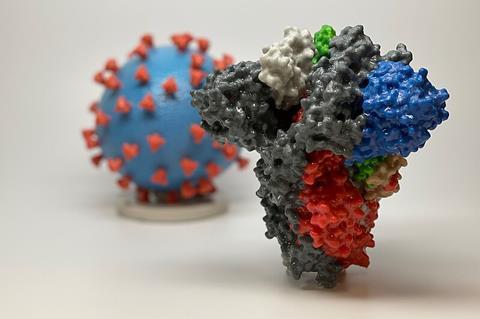Viruses have all kinds of tricks up their sleeves. It often does not take long for pathogens such as SARS-CoV-2 to adapt and escape immune recognition. Viruses with mutations, that evade immune recognition more efficiently than the original virus will have a selective advantage and prevail over time, increasingly dominating the infection landscape.

“If the new virus variant can successfully escape the immune response, it is no longer sufficient to have recovered from one of the previous variants or to have been vaccinated with a previously effective vaccine,” says Prof. Luka Cicin-Sain, head of the department “Viral Immunology” at the HZI.
“With vaccine development, we are always playing catch-up with the spread of new escape variants. That’s the very nature of virus evolution. Nevertheless, we need to outsmart the viruses and reduce their advantages, both for currently circulating ones and for those that will be around in future pandemics.”
Mutational scanning
A swift identification of mutations that are crucial for the immune escape enables the rapid adaptation of vaccines to new virus variants. In their current study, the team led by Cicin-Sain presents a promising new approach for doing just that.
It is based on a previously established method called mutational scanning: Each mutation found in the new variant is introduced separately into the original virus to generate a library of virus mutants. The effects of each individual mutation can thus be defined by comparing the mutants from the library to the original and to the new virus variant.
However, in their study, the HZI researchers modified the procedure by introducing the mutations one by one into the new virus variant to make it resemble the original virus at each position. Hence, they used the methodology in reverse, which is why they called it reverse mutational scanning.
How it works
What exactly is the process behind reverse mutational scanning and how did the research team go about it? To test their new approach, the scientists examined viral variants of SARS-CoV-2 as an example. They wanted to find out which of the 33 mutations that distinguish the BA.2.86 virus variant from the original BA.2 variant are responsible for immune escape.
READ MORE: Teardrops target multiple COVID variants through the twist in the spike protein
READ MORE: New antibody breakthrough offers hope against evolving SARS-CoV-2 variants
Using advanced genetic methods, the researchers produced so-called pseudoviruses, which use the SARS-CoV-2 spike protein to enter cells, but are unable to replicate and are therefore harmless to humans and the environment. The researchers started from the new virus variant with immune escape, i.e. BA.2.86.
“To find out which mutations are responsible for the immune escape of this virus variant, we created various pseudoviruses in which one of the 33 different mutations was reversed, in the direction of the original virus BA.2,” explains Dr. Najat Bdeir, a scientist in the department “Viral Immunology” at the HZI and first author of the study.
Real life samples
In extensive cell experiments, the researchers then investigated how well the respective pseudoviruses could be combated by immune cells. To do this, they used samples ‘from real life’.
“For the study, we were able to provide blood sera from a cohort of 40 people working in the healthcare sector,” says Prof. Georg Behrens from the Department of Rheumatology and Immunology at Hannover Medical School. ”The participants had been vaccinated multiple times, including with the then-current vaccine that was effective against Omicron XBB.1.5.”
Backwards takes us forwards
Using reverse mutational scanning, the researchers identified that three mutations in the spike protein were responsible for immune escape. But why is it important to start with the new virus variant and reverse the individual mutations, thus applying mutational scanning in “reverse”?
“This is important because our immune cells are very diverse. They can make antibodies that bind to different parts on the virus and thus block the infection process,” explains Cicin-Sain.
”If we start from the original variant and insert a mutation in an area that is actually recognized by antibodies, there is a high probability that antibodies binding to another part of the virus will still recognize and neutralize the virus. The actual contribution of the mutation to immune escape cannot be adequately detected in this way. So we have to start from the new variant and work backwards from there – backwards takes us forwards here!”
Overtaking the virus
The researchers hope that their new method can also advance and accelerate future vaccine development. With reverse mutational scanning, other viruses and their variants could be analyzed for mutations responsible for immune escape.
“It would also be conceivable to use this new method to train machine learning and AI models to predict which potential mutations of a virus could lead to immune escape,” says Cicin-Sain. ”If we could produce vaccines based on pre-adapted vaccines, we would be faster than the virus!”
In addition to Luka Cicin-Sain’s department “Viral Immunology”, Prof. Wulf Blankenfeldt’s department “Structure and Function of Proteins” of HZI was also involved in this study. Scientists from the Centre for Individualised Infection Medicine (CiiM), German Primate Center – Leibniz Institute for Primate Research and the Leibniz Institute DSMZ – German Collection of Microorganisms and Cell Cultures, along with the German Center for Infection Research (DZIF) also contributed with their expertise to this study.







No comments yet